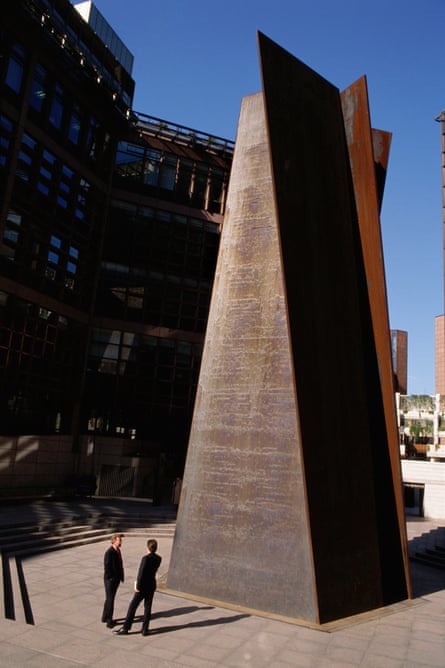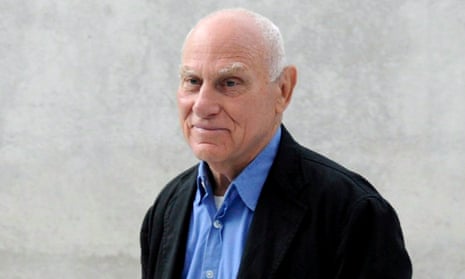Richard Serra, the American artist known for bending the boundaries of sculpture, has died at the age of 85.
Serra died at home on Tuesday at his home in New York. The cause of death was pneumonia, his lawyer John Silberman confirmed to the New York Times.
Serra was best known for his gigantic curved sheets of oxidised steel, such as the 1,034-tonne series The Matter of Time that fills the main hall of the Guggenheim Museum Bilbao. Such weighty works radically transformed the spaces where they were installed and were often said to instil a physical reaction in their viewers. “I’m working at the edge of what’s possible,” Serra once said.
Serra was born in San Francisco in 1939 to a Russian-Jewish mother and a Spanish father, who fitted pipes in a shipyard. The young Serra was inspired by seeing a ship launched as a child and was encouraged to draw by his mother. He studied fine art at Yale alongside peers who included Chuck Close and his eventual first wife Nancy Graves – but was suspended for two weeks after pulling a prank on the visiting critic, artist Robert Rauschenberg, that involved bringing a live chicken into class.

Serra found inspiration during a trip to Paris with Philip Glass, during which he visited the studio of Constantin Brâncuși and hung around the haunts of his hero Alberto Giacometti. But it was in Spain, while seeing Diego Velázquez’s painting Las Meninas – a 17th–century group portrait that plays with the notion of viewing – that Serra began to reconsider everything he knew about art. He went through a period of “total confusion” that included working with stuffed animals, before reinventing his practice around sculpture and the idea that the viewer themselves would be the true subject of his work.
“The whole subject-object relationship is reversed. The content is you!” he told the Guardian in 2008. “If you don’t walk into the work and engage with it, there isn’t any content.”
Serra spent much of the 1960s as part of the underground art scene in New York, where he worked with unconventional materials such as latex, neon and molten lead – the last used for his “splash pieces”, in which he threw it at the base of walls then let it harden into ragged metal. As the decade drew to a close he had a breakthrough with Strike: To Roberta and Rudy, in which he divided the room into two with a plate of steel and found himself closer to his aim of toying with the viewer’s perspective.
In 1970 Serra divorced Graves and began creating site-specific landscape sculptures, in Japan, Canada and across the US, focusing on each location’s topography and how the work would interact with it as the viewer walked around it. But it was his urban sculptures that caused the most controversy. In 1981, when Tilted Arc was installed in Manhattan’s Federal Plaza, the 120ft-long (36.5 metres) stretch of rusting steel split opinion, with those critical labelling it an eyesore. Serra even recalled seeing posters emblazoned with the phrase “Kill Serra”. During a public hearing in 1985, a jury voted for the sculpture’s removal. Serra went as far as to sue the US government over the verdict but failed. The work was cut into three parts and now resides in a warehouse in Brooklyn. “‘I don’t think it is the function of art to be pleasing,” Serra complained at the time, likening the loss of the sculpture to a death in the family.

But as he grew older the public warmed to his huge steel works, which seemed to reference the industrial age and the shipyards of his childhood. Fulcrum, his 1987 installation near London’s Liverpool Street station, fared better than Tilted Arc. Affection for his work began to accelerate in the following decade when he broke with the right angles of modernism and embraced curvature. His Torqued Ellipses, made in the 1990s using rolled steel plates, could all be entered and walked around. The Matter of Time, eight curved sculptures made between 1994 and 2005 for the Guggenheim Museum Bilbao, became his career-defining work. Two years after they were installed, Serra received his second retrospective at New York’s Museum of Modern Art. His work has been installed in landscapes and museums across the globe, from Iceland to Zealand via Qatar.
Married to the art historian Clara Weyergraf since 1981, Serra remained active as an artist into his 80s, describing a 2019 show at New York’s Gagosian Gallery as his “heaviest show ever”. Up until his death he was regarded as the best-known living sculptor in the US, his heavy, physical work increasingly at odds with the airy ephemera of the digital era. Indeed, when asked by the conceptual artist Michael Craig-Martin in 2015 which other artists approached sculpture like he did, he replied: “I don’t think anyone does.”
